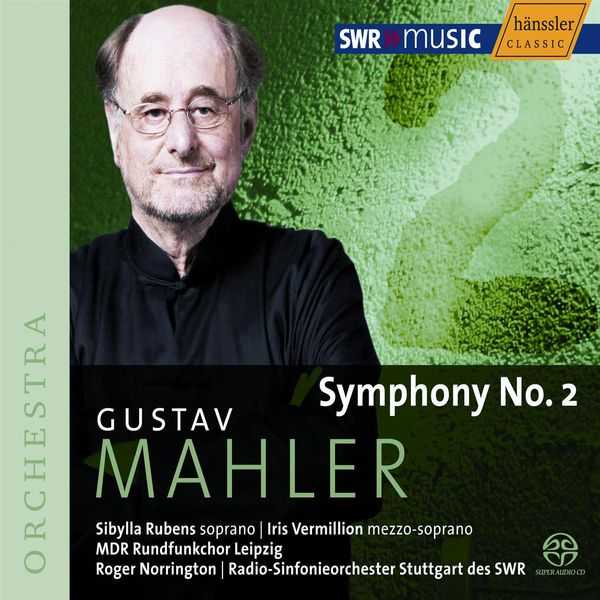
Composer: Gustav Mahler
Performer: Sibylla Rubens, Iris Vermillion, MDR Rundfunkchor
Orchestra: Radio-Sinfonieorchester Stuttgart des SWR
Conductor: Sir Roger Norrington
Format: FLAC (tracks)
Label: Hänssler
Catalogue: HAEN93166
Release: 2007
Size: 282 MB
Recovery: +3%
Scan: cover
Symphony No. 2 ‘Resurrection’
01. I. Allegro maestoso
02. II. Andante moderato
03. III. In ruhig fliebender Bewegung
04. IV. Sehr feierlich, aber schlicht, “Urlicht”
05. V. Im Tempo des Scherzos, wild herausfahrend
This is the fourth in the Hanssler series of live recordings of the Mahler symphonies, and in it they try as hard as ever to recreate the sound world which Mahler might have expected. Of course the most striking features of this strategy are the ‘German seating’ (with violins opposite each other and basses across the back of the orchestra) and the ‘Pure Tone’ normal with all orchestras until the 1920s. Pure tone offers unanimity of sound, transparency, telling harmonies and the possibility of far more engaged phrasing and dynamics.
Roger Norrington established his credentials as a conductor of early music, and he became famous for his meticulous re-creations of music from the Baroque to the early Romantic periods. Now he has expanded his purview to include late- and post-Romantic works, such as the symphonies of Gustav Mahler, though Norrington still prides himself on his scholarship and insists on giving these massive works the most thoroughly researched, historically informed, and technically accurate performances he can achieve. However, Mahler’s music has become familiar to us through decades of intensely Romantic interpretations, from Bruno Walter and Leonard Bernstein to Georg Solti and Herbert von Karajan, and beyond, and many listeners have developed a taste for histrionic, explosive, and monumental interpretations, notwithstanding attempts by Benjamin Zander and some other conductors who aim for historicity. Norrington, of course, strives to give us Mahler’s works as he heard them, and delivers the Symphony No. 2 in C minor, “Resurrection,” with features of the period’s practice: violins face each other, vibrato is reduced in the strings in general, and details in the score — in this case, the 2006 Universal Edition — are followed with scrupulous fidelity. But Norrington’s performance of the symphony with the SWR Stuttgart Radio Symphony Orchestra feels rushed, constrained, rigid, emotionally cool, and dramatically diminished, all because of their fastidiousness in observing the letter of the score, rather than its spirit. The “Resurrection” Symphony is nothing without its terror, its brooding, its mystery, its longing, and its ecstasy, and Norrington’s painstaking and clinical approach fails to get any of these emotions across. Listeners may feel that some restraint is needed in Mahler, after years of excesses, but this version is almost too controlled; though Norrington surely never intended his performance to be sterile, this “Resurrection” is overly cautious, clinical, and certain not to raise the dead. Hänssler’s reproduction for this hybrid SACD is immaculate, so every detail in this fussy rendition is audible.